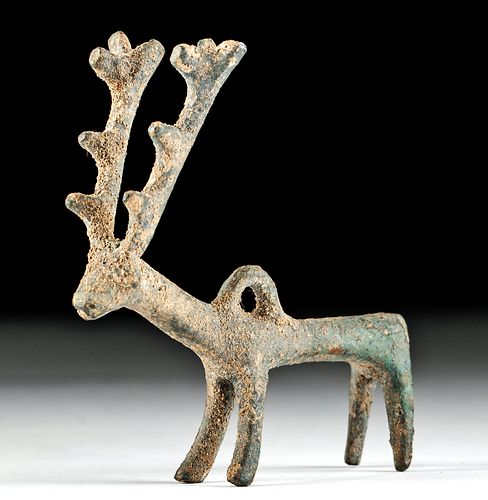Luristan Leaded Copper Stag Pendant
Lot 71a
About Seller
Artemis Fine Arts
686 S Taylor Ave, Ste 106
Louisville, CO 80027
United States
Selling antiquities, ancient and ethnographic art online since 1993, Artemis Gallery specializes in Classical Antiquities (Egyptian, Greek, Roman, Near Eastern), Asian, Pre-Columbian, African / Tribal / Oceanographic art. Our extensive inventory includes pottery, stone, metal, wood, glass and textil...Read more
Categories
Estimate:
$1,800 - $2,500
Absentee vs Live bid
Two ways to bid:
- Leave a max absentee bid and the platform will bid on your behalf up to your maximum bid during the live auction.
- Bid live during the auction and your bids will be submitted real-time to the auctioneer.
Bid Increments
| Price | Bid Increment |
|---|---|
| $0 | $25 |
| $300 | $50 |
| $1,000 | $100 |
| $2,000 | $250 |
| $5,000 | $500 |
| $10,000 | $1,000 |
| $20,000 | $2,500 |
| $50,000 | $5,000 |
| $100,000 | $10,000 |
| $200,000 | $20,000 |
About Auction
By Artemis Fine Arts
Feb 13, 2020
Set Reminder
2020-02-13 10:00:00
2020-02-13 10:00:00
America/New_York
Bidsquare
Bidsquare : Exceptional Antiquities, Asian, Ethnographic
https://www.bidsquare.com/auctions/artemis-gallery/exceptional-antiquities-asian-ethnographic-4848
An important one-day auction featuring museum-worthy examples of Egyptian, Greek, Roman, Etruscan, Near Eastern, Far East / Asian, Pre-Columbian, African / Tribal, Oceanic, Native American, Spanish Colonial, Russian, Fossils, Ancient Jewelry, Fine Art, so much more! Artemis Fine Arts info@artemisfinearts.com
An important one-day auction featuring museum-worthy examples of Egyptian, Greek, Roman, Etruscan, Near Eastern, Far East / Asian, Pre-Columbian, African / Tribal, Oceanic, Native American, Spanish Colonial, Russian, Fossils, Ancient Jewelry, Fine Art, so much more! Artemis Fine Arts info@artemisfinearts.com
- Lot Description
Ancient Near East, northwestern Iran, Luristan culture, ca. 1000 to 600 BCE. A charming pendant in the shape of a standing stag, cast from leaded-copper and exhibiting smooth patina in hazy hues of grey, blue, and green. The petite stag supports its elongated body atop four slender legs and has a thick tail draped atop the hind quarters, with an integral suspension loop arching atop the back, and a lengthy neck extending from the shoulders. The triangular head displays characteristic stag features such as a conical snout, bulging eyes, and a slit-form mouth, and from the skull project two enormous antlers with three laterally protruding nodules and a bifurcated upper tip. The stag is a symbol of virility and masculinity, and the yearly antler shedding is symbolic of the annual renewal of the agricultural cycle. Size: 2.5" L x 1.1" W x 2.7" H (6.4 cm x 2.8 cm x 6.9 cm)
For three stylistically similar examples with shorter antlers, please see "The Muse's Song: Selections of Ancient Art." Fortuna Fine Arts, Ltd., New York, 2008, fig. 14.
Another stylistically similar example, with a fawn riding on its back, hammered for GBP 2,390 ($3,128.83) at Christie's, London "A Peaceable Kingdom: The Leo Mildenberg Collection" auction (sale 7017, October 26-27, 2004, lot 373).
Provenance: private East Coast, USA collection; ex-Noah Weber collection, USA, acquired in the 1970s
All items legal to buy/sell under U.S. Statute covering cultural patrimony Code 2600, CHAPTER 14, and are guaranteed to be as described or your money back.
A Certificate of Authenticity will accompany all winning bids.
We ship worldwide and handle all shipping in-house for your convenience.
#153163Very slight bending to overall form of some legs and antlers, with light encrustations, otherwise intact and excellent. Light earthen deposits and wonderful patina throughout.Condition
- Shipping Info
-
All shipping is handled in-house for your convenience. Your invoice from Artemis Gallery will include shipping calculation instructions. If in doubt, please inquire BEFORE bidding for estimated shipping costs for individual items.
-
- Buyer's Premium



 EUR
EUR CAD
CAD AUD
AUD GBP
GBP MXN
MXN HKD
HKD CNY
CNY MYR
MYR SEK
SEK SGD
SGD CHF
CHF THB
THB















